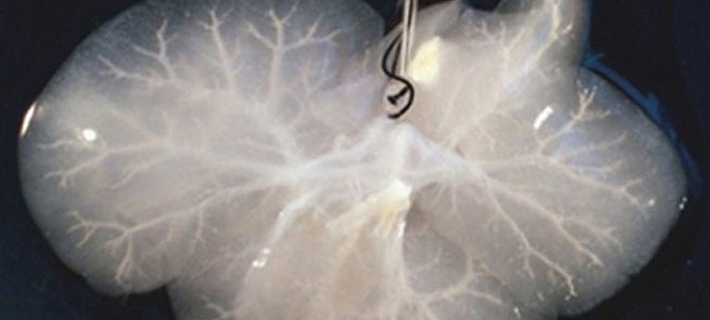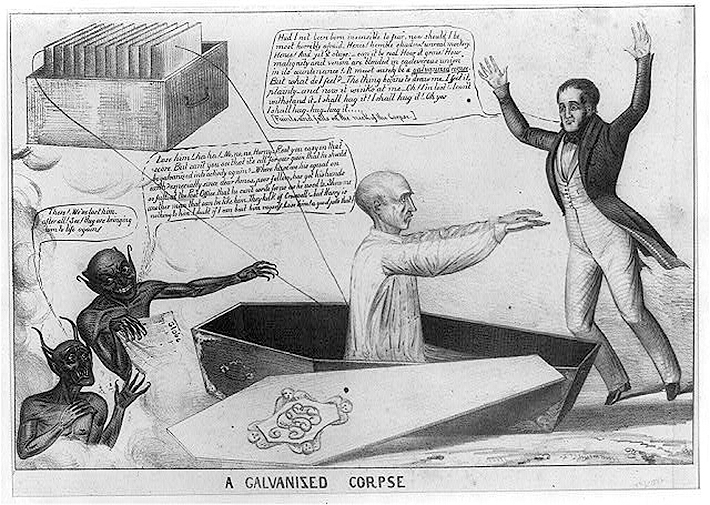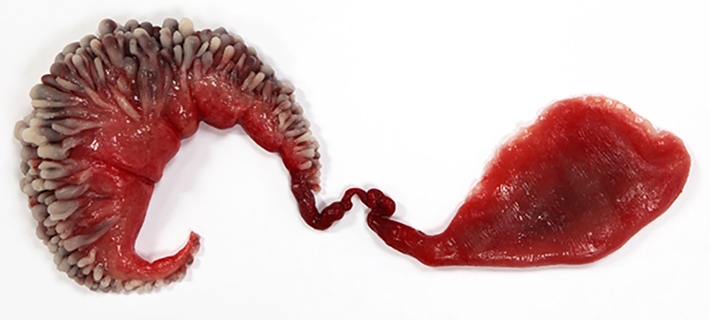Bioengineering has experienced vast developments in recent years, providing solutions to a number of real-world problems. Genetically-modified crops can help solve food shortages, gene therapy has been instrumental in providing relief for sufferers of certain conditions and developments in organ bioengineering may soon provide a life-saving solution for thousands on the organ donor waiting list. Yet bioengineering has also faced a great degree of resistance, especially regarding genetic engineering, as some people warn that we should exercise more caution when attempting to control the very chemical basis of life forms.
It has been suggested that this act of 'playing God' is as foolishly ambitious as Prometheus' decision to defy the Gods and make his own race of Man from clay. As the subtitle of Mary Shelley's 'Frankenstein' suggests, Man's desire to create and control life has long been considered as immoral and dangerous. However, with such knowledge at our fingertips to provide life-saving and life-enhancing solutions, wouldn't it be foolish and immoral to avoid using it?
For those facing end-stage organ failure, the only option currently available is organ transplantation. Though more and more people are becoming aware of the importance of joining the organ donor register, there are currently just over 7,000 patients on the waiting list for a solid organ transplant and the need for organs still far exceeds the number of donor organs. In the last financial year, up to March 31st 2013, there was an 11% increase in the number of deceased donors from the previous year, reaching the highest number in the UK so far. The number of patients whose lives were saved or improved by an organ transplant increased by 6% to 4,212. In spite of this, 466 patients died while waiting for a transplant and a further 766 were removed from the transplant waiting list, mainly as a result of deteriorating health. There are still a huge number of people who are suffering due to a shortage of organs, and this is not the only complication.
The adverse effects of immunosuppression can be damaging or even fatal. When an organ is transplanted, the recipient's body will recognize the cells as not being its own and will try to attack it, thinking it a disease-causing pathogen. The organ will be destroyed unless immunosuppressant drugs are given to reduce the patient's immune response to the new organ. However, these can make the body vulnerable to opportunistic infections, and some infections that would otherwise be harmless to the patient can be dangerous when their immune system is compromised.
Science Fiction has pursued this problem in search of possible solutions: some within the possibilities of current scientific development; some stretching the boundaries; some bizarre and some down-right terrifying. Many films and novels have also explored the possible repercussions of a shortage of organ donors, including the depiction of dystopian worlds where the shortage has resulted in the emergence of ethically-dubious industries.

Credit: jason-courtney / DeviantArt
In Margaret Atwood's dystopian trilogy which opens with 'Oryx and Crake', a solution to the shortage of organ donors appears in the form of a pig-human genetic hybrid. 'Pigoons' are genetically-modified, laboratory-grown animals that are grown to huge sizes and have many organs. These organs, including skin and brain tissue, are harvested for transplanting into humans. The pigoon organs are grown from human tissue, so they are less likely to be rejected by their eventual recipient.
Pigoon was only a nickname: the official name was sus multiorganifer. But pigoon is what everyone said... The goal of the pigoon project was to grow an assortment of foolproof human tissue organs in a transgenic knockout pig host - organs that would transplant smoothly and avoid rejection, but would also be able to fend off attacks by opportunistic microbes and viruses, of which there were more strains every year. A rapid-maturity gene was spliced in so the pigoon kidneys and livers and hearts would be ready sooner, and now they were perfecting a pigoon that could grow five or six kidneys at a time. (Atwood, Oryx and Crake)
The benefits of such a system are numerous, as they allow the mass-production of life-saving organs for a quickly expanding population. Atwood acknowledges the need to avoid the use of immunosuppressant drugs following transplantation, however, the fact that these pigoons have a mixture of pig and human DNA means that they could be seen as crossing the boundary between animal and monster. The creatures are designed to live on even after the 'harvesting' of their organs, however suspicions are raised by the first collection of 'single-use' pigoons.
In the cafeteria of the bioengineering company where the pigoons are produced, there is an suspicious increase in the number of pork products on the menu around the time of pigoon harvesting. Some characters are unconcerned by this, while others raise the issue of cannibalism, as the pigoons are created with human DNA. Though Atwood's human-animal hybrids seem to form part of a cautionary tale, we are about to see why the use of both animal and human tissues is likely to be very important in providing a solution that does not require the use of immunosuppressant.
New solutions for organ transplantation, involving tissue engineering, and even whole organ engineering, are being pursued, with some amazing results. The growth of relatively simple tissues, including blood vessels, urinary bladders and trachea, have shown great development in recent years. 3D printing has already delved into organ bioengineering, as a replacement human ear was recently created using rat tail cells and cow cartilage. However, these organs don't require a large vascular network to be functional. When it comes to producing more complex organs, such as lungs, livers, kidneys and hearts, structural problems arise.
Vascular networks in human organs for organ transplant would need to be capable of nutrient and gas exchange. Such functional networks are complex and difficult to reproduce from artificial materials. Therefore, scientists are now contemplating decellularisation techniques to strip natural solid organs of their living cells. This leaves intact structures with accurate and functional vascular systems for Xenotransplantation. The extra-cellular matrix (ECM) remains, which acts as a scaffold on which new cells can be grown. It maintains the tissue architecture and also provides biological signals that are essential to its function. However, it is important that the decellularisation process does not destroy or damage this naturally-derived matrix that will provide the scaffold for the new organ.
The decellularisation process involves the destruction of living cells, by repeatedly freezing and thawing the organ, in addition to exposure to detergents. The detergents used must be selected carefully and known not to affect the integrity of the protein in the extra-cellular matrix tissue. The organ could be submerged in a detergent solution that kills off the living cells, in a process known as Immersion decellularisation. Alternatively the detergent is pumped continuously through the organ in the process of Perfusion decellularisation. Before the next step, the organ undergoes scrutiny through light/fluroscopy and other imaging techniques to ensure the decellularised organ's vascular structure remains intact.

Decellularised liver.
Credit: Wake Forest University Baptist Medical Center
When just the Extracellular matrix of the organ remains, the next step is the recellularisation. There are a variety of cell types that are being investigated as potential candidates for this process. The ideal cell type would be easily isolated, grown rapidly and cost-effectively in vitro and would be easily prompted to differentiate to various cell types. Such cells under investigation include whole lung cell suspensions, endogenous progenitor cells, embryonic and adult stem cells and induced pluripotent stem (iPS) cells. However, the ideal situation would be to take cells from the patient to repopulate the acellular organ structure, as it would reduce the need for immunosuppressive drugs following the transplantation. This would result in an organ that was an animal-human hybrid akin to that of the pigoon organs in Atwood's novel.
There are a few complications which mean that this decellularisation process works in practice but is still a long way from having its successes translated to the clinic. Most importantly, an optimal source of donor organs needs to be found. So far, rat, pig and mouse organs have been experimented with. It appears that Margaret Atwood's pigoons are not too far from the truth, as porcine acellular matrices have a number of advantages that make them a preferable choice. A pig's organs are similar in size to human organs and provide a low risk of transmission of infectious agents.
"Perhaps a corpse would be reanimated; galvanism had given token of such things." Mary Shelley
The stripping of a real, functioning organ of its living cells to 'reanimate' for further use in another organism seems like an idea pulled straight from science fiction. This 'resurrection' could be compared with the attempts made by Victor Frankenstein to reanimate dead tissue in Mary Shelley's 'Frankenstein'. However, instead of using animal organs, Frankenstein accumulated the body parts of deceased humans to make his monster. He "dabbled among the unhallowed damps of the grave" and robbed dissecting rooms and slaughterhouses. Because of the difficulty in replicating small parts of the human body, his monster was uncommonly tall. It was intended to be beautiful, but the result was hideous, with yellow eyes and skin, barely concealing muscles and blood vessels underneath.
Shelley is likely to have been inspired by the experiments of Italian physician Luigi Galvani, from whose name the word 'Galvanism' was derived, though the term has only been used historically. In the 1780s and 1790s, Italian physician Luigi Galvani conducted experiments exploring the effect of electricity on dissected animals. One day in the lab, Galvani's scalpel touched the leg of a dissected frog and he saw the muscles in the frog's leg twitch. He assumed that the electricity was produced by the frog itself and named the phenomenon 'animal electricity'. Galvanism, and the reanimation of tissue with electricity, is popularly associated with Mary Shelley's 'Frankenstein' though this is only explicitly stated in the 1831 revised edition of Shelley's novel. Though Galvani's experiments demonstrated what we now know to be the basis of nerve impulses in the stimulated muscles, the animation he witnessed was far from the resurrection that he believed it to be.

'A Galvanised Corpse'. Jacksonian editor Francis Preston Blair rises from his coffin, revived by a primitive galvanic battery, as two demons look on. A man on the right throws up his hands as he is drawn toward Blair, saying: Had I not been born insensible to fear, now should I be most horribly afraid. Hence! Horrible shadow! Unreal mockery. Hence! And yet it stays: can it be real. How it grows! How malignity and venom are 'blended in cadaverous union' in its countenance! It must surely be a 'galvanized corpse.' But what do I feel? The thing begins to draw me... I can't withstand it. I shall hug it!
Credit: H.R. Robinson - 1836
Frankenstein's creature is originally benevolent and peaceful, but is rejected by society for its appearance. Shelley seems to be suggesting that it is society's extreme reaction to the 'Other' which drives the creature to become the monster they believe it to be. The analogy could be applied to these decellularised organs - the process can save lives and improve others, and though it is likely to be met with a certain degree of caution and even repulsion, the only hindrance to its success may be our inability to accept it.
So far, our attention has been on transplanting existing organs from humans and animals, but more appealing perhaps to the SF imagination is the idea of creating bespoke organs to fulfil a function that humans cannot perform at present. A synthetic biology project by design graduate Agatha Haines explores such ideas, as she has focused on utilising both 3D printing and bioengineering to create bizarre new organs with interesting properties. Her exhibition 'Grow your own : Life After Nature' which is currently at Trinity College, Dublin, suggests the use of cells from rattlesnakes and leeches, among other animals, to create organs that would combat a variety of health problems. She proposes a 'defibrillator organ' made of the cells of an electric eel, which upon signals of a heart attack, would send an electric pulse to restart the heart.

Defibrillator organ.
Credit: Agatha Haines
As this is an idea that has originated in the world of art and design rather than science, it is understandable if it is met with cynicism. However, it may also go to show how beneficial the interplay between art and science can be in order to create new ideas and eventually put these ideas into practice.
As far as bioengineering goes, this is just the tip of the iceberg. From human augmentation to the creation of artificial meat, there are numerous topics to be covered in this field, and developments are being made at an alarming rate. I hope to cover a few of these in the coming weeks and months, so please keep involved and keep reading if you're interested in topics such as these.
References & Further Reading
- Atwood, "Oryx and Crake", Virago Press (2004).
- Shelley, "Frankenstein; or, The Modern Prometheus", Lackington, Hughes, Harding, Mavor & Jones (1818).
- Arenas-Herrera et al, "Decellularization for whole organ bioengineering", Journal of Biomedical Materials (2013).
- Mannoor et al, "3D printed bionic ears", Nano Letters (2013).
- Moran et al, "Whole-organ bioengineering: current tales of modern alchemy", Translation Research - Journal of Laboratory and Clinical Medicine (2014).
- NHS Organ Donation Website.
Listing image: Chidog-01 / DeviantArt
